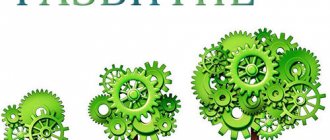Unlike other living beings, man has a dual nature. On the one hand, his behavior is influenced by features of anatomy, physiology, and psyche. On the other hand, he obeys the laws of society. If in the first case we are talking about the formation of a person as an individual, then in the second there is the development of personality. What is the difference between these processes? What is personality? Why is it formed in society? What stages does it go through in its improvement? Are there many levels of personality development? What mechanisms trigger this process? Let's consider this topic.
Psychology of personal growth through motivation
“Psychology of personal growth” and “psychology of personality development” are similar concepts, but they are not much different. Many experts have repeatedly started discussions on the topic of the relationship between these branches of psychology, and only now their similarity has been proven. The fact is that the psychology of personality development itself goes shoulder to shoulder with the psychology of personal growth; they are completely interconnected and cannot exist without each other. It is about them that we will tell our readers today.
Personality is a high concept, meaning a fully formed and socialized person in the modern world, and possessing the psychological characteristics necessary for life in society.
Let's start with the fact that “ personal growth ” is a concept that came to us from the branches of the science of psychology. If we break down the term “psychology” itself, we will see that it consists of two ancient Greek words: “teaching” and “soul,” thereby showing us that the study of the human soul is worthy of a separate niche in the scientific world.
If we return to the psychology of personal growth, then it already studies in more depth the concepts of the laws of personality development and the very vision of the original human nature in a positive way. This section of psychology helps to develop a person’s inner potential and give him an impetus on the path of self-development.
The path in personality development psychology
Human nature and the path to personal self-education
Human nature has its own classification in psychology:
- Definitely positive;
- Conditionally positive;
- Neutral;
- Damaged.
Already based on the identified human nature, it is possible to build a path to personal growth.
For example, in the “unconditionally positive” nature of a person, the meaning of education will be the help of a psychologist in actualizing him. With a “conditionally positive” human nature, the meaning of education will change to the existential approach of a psychologist in helping with choice.
If we take neutral human nature, then the meaning of education will be the formation and correction of personality by a psychologist. As for the last variation of human nature - damaged, here a more difficult task will fall on the shoulders of the psychologist - correction and compensation.
The origins of the psychology of personal growth
If we return to the origins of the theory of the psychology of personal growth, then we should thank its “fathers”, American psychologists Carl Ransom Rogers and Abraham Harold Maslow. It was they who once created their own humanistic concept, within the framework of which the psychology of personal growth was formed.
Psychology of personal growth in the modern world
Years of practice and work of many talented psychologists have “polished” the psychology of personal growth in their own way, transforming it into a convenient tool for conducting motivational training on human self-development.
In modern practice, such training is especially popular among psychologists and their students. But it is worth noting that the original theory of the psychology of personal growth acquired its own new features over time.
For example, our contemporary, business coach Grigory Spizhevoy, authored a new book on the topic of personal growth. His theory includes such concepts as “inner harmony”, “relationship with oneself”, “I+I relationship”, “I+other relationship”, “relationship with the outside world” and, of course, “self-development”. According to Spizheva, all these concepts constitute the entire psychology of personal growth.
Personal development in psychology
Personal development is a branch of psychology that deals with personal growth and self-development. This section of the psychology of personal development includes all changes in the psychological attitudes and processes of a person as an individual, under external and internal influences on him.
Personal development can be formed in a person not only with the help of his independent work, but also under the influence of any other external factors. The development of a person’s personality is a rather long process that accompanies him throughout his entire life journey. This can also affect personal development in human psychology, thanks to his continuous interaction with the outside world and other people.
To some extent, the human psyche is like a sponge. She absorbs everything that happens around her, which is reflected in a person’s personal self-development and development. That is why, in some cases, even an already formed personality needs correction by a professional psychoanalyst. Photo 4 – the result of personal development in psychology – complete harmony with oneself.
Main directions of human development
“There is no doubt that a lot depends on the general routine in the institution, but the most important thing will always depend on the personality of the immediate educator, who faces the world of the student. The influence of the educator’s personality on the young soul constitutes that educational force that cannot be replaced by either a textbook or moral maxims, nor a system of punishments and rewards"
When they talk about human development, they usually consider not development in general, but only some of its individual directions. Most often in pedagogy the following main directions of human development are mentioned (Fig. 1):
· physical,
· intellectual,
· ethical,
· social,
· aesthetic.
Figure 1. Main directions of human development
Each of these areas certainly deserves special attention, and each of them has its own methods of developmental education. However, it is advisable to look for some general theoretical basis for these methods, to find general patterns of development, regardless of the type of direction of development.
If we compare the above directions of development with each other, we can see that they are all in one way or another connected with various aspects of human behavior. Human behavior is regulated by a special mechanism called the psyche. The emotion evoked by a work of art, a heroic deed, and the solution of a complex mathematical problem are all behavioral phenomena that arise and are controlled by the human psyche.
So, the psyche is the property of an organism to reflect objective reality and, on the basis of the mental image formed at the same time, it is advisable to regulate the behavior of the subject.
All behavioral manifestations, both observable and hidden, are determined by the psyche, depend on the psyche, that is, they are mental functions.
Mental functions include the simplest reactions, such as withdrawing a hand when touching a hot kettle, and such complex internal processes as thinking about solving a scientific problem.
Thus, the psyche is a kind of conductor, under whose leadership both the entire organism as a whole and its subsystems function, and various tasks related, first of all, to survival at the level of the organism, genus and population are solved.
Therefore, the patterns of mental development can become the theoretical basis through which most areas of human development can be described, including the development that occurs during the learning process.
However, we must not forget that such body systems as nervous, circulatory, musculoskeletal, reproductive, etc. are closely connected with the human psyche. These systems also participate in the process of development of the body and play a significant role in it.
Therefore, mental development should not be considered in isolation, but in the context of the process of overall development of the organism from birth to the end of life.
Personality development and its patterns
Personality is a person as a subject of relationships and conscious activity, capable of self-knowledge and self-development. A person becomes a person in the process of development.
Development
– a process of quantitative and qualitative changes in the body, psyche, intellectual and spiritual sphere of a person, caused by the influence of external and internal, controllable and uncontrollable factors.
Properties and patterns of development
:
- Immanence
: the ability to develop is inherent in a person by nature, it is an integral property of the individual.
Biogenicity
: the mental development of an individual is largely determined by the mechanism of heredity.
Sociogenicity
: the social environment in which human development occurs has a huge impact on the formation of personality.
Psychogenicity
: a person is a self-regulating and self-governing system, the development process is subject to self-regulation and self-government.
Individuality
: personality is a unique phenomenon, distinguished by an individual selection of qualities and its own version of development.
Staged
: personality development is subject to the stages of origin, growth, culmination, withering, decline.
Unevenness
(nonlinearity): the individual is unique, each personality develops at its own pace, experiencing randomly distributed accelerations (spontaneity) and growth contradictions (crisis).
Physical age determines the quantitative (limited) and qualitative (sensitivity) possibilities of mental development.
Developmental education takes into account and uses developmental patterns and adapts to the level and characteristics of the individual.
DEVELOPMENTAL AND FUNCTIONAL TRAINING: GOALS, MEANS, RESULTS
Can training not be developmental? The paradoxical nature of this formulation of the question is almost obvious. In fact, no matter what we teach a child, one way or another he develops, some changes occur in his consciousness, personality, and abilities. Different types of training can make different contributions to development and produce different developmental effects, but that’s another question—assessing the developmental effect. Does this give grounds to divide education into developmental and non-developmental? Undoubtedly, all learning is internally connected with development and one of the results is development. The problem is how learning and development are related.
The relationship between learning and development processes can be different. R
the result of any training is always some shifts in development, but they are either a direct result, a product at which the training is aimed, or just a side effect.
Training may be aimed not at development, but at the functional preparation of a person,
and it does not at all ask the question of how a person develops.
There is another criterion: how it performs certain functions. The goal of such training is a certain minimum, an optimum of knowledge, abilities, skills,
the so-called “zoons”.
Is there any development going on? Yes, but it is not planned, it happens spontaneously and unpredictably, it can be larger, smaller, etc. Development is meant here as a certain prerequisite for learning.
It exploits spontaneous results, spontaneous achievements of development, adapts to them, takes them into account, etc. (for example, differentiation of training depending on interests, abilities; testing, selection, etc.)
But training itself does not plan development at all, is not directed and not designed for him.
Another option is training that is specifically designed for a certain developmental level of children.
Will the child gain skills, knowledge, and abilities in this training?
Undoubtedly, but the difference with the first option is only in one thing: if there development is an unpredictable, spontaneous consequence, then here it is a direct, planned result.
And knowledge, skills and abilities are transformed from goals into means of achieving results. They cease to be an end in themselves.
These two types of training seem to differ not only in their goals, but also in their means.
If the goal is to provide knowledge, skills and abilities, training should be based on conscious (or unconscious - this is not so important) patterns of assimilation.
If we want to ensure a certain guaranteed result in development, naturally, it is necessary to implement the laws of development. Is it necessary to take into account patterns and possibilities of assimilation? Yes, undoubtedly, otherwise all our attempts will end up with unsuitable means, they will be doomed to failure. But the patterns and possibilities of assimilation themselves may be different depending on how the patterns of development are implemented. Patterns of development act as a criterion for accessibility, and it is a very powerful criterion. We can proclaim any requirements for education, but the first question that arises when organizing the process is accessibility. If this is not accessible to children, all other criteria: scientificity, consistency, historicism - lose all meaning.
The accessibility criterion determines the content and methods,
that is, by implementing the patterns of development, we change the conditions and opportunities (the accessibility criterion) for the use of certain teaching methods and the implementation of certain patterns of mastering knowledge, skills and abilities.
The point, of course, is not to proclaim the priority of development over assimilation. Such declarations do not change life. The question is different: in the real orientation of learning towards certain patterns. Traditional education, up to this day, is entirely focused on “equipping” the younger generation with a certain set of “zoons” or an even more intriguing goal - “preparing for life.” It follows from this that life begins after school, and the fact that at school is a kind of prologue to it. This approach completely excludes the very principle of humanizing learning. The result is inhumane training. It is this that has received a permanent “registration” in our schools. However, another type of education has the right to exist, which is designed for the development of the child, considering him as an individual living today, and creating the most favorable conditions for his development. Only in this sense is it possible to distinguish between the concepts: developmental learning and non-developmental learning (otherwise known as functional).
The main focus of functional training is preparation for performing certain functions. The tasks of education are also subordinated to the same goal. Essentially, this is the same functional training, only not of the mind and hands (as in training), but of the soul. The split into two processes: education and training reflects the very fact of functionality. By diligently supplementing the educational process with educational process, we are trying to combine the incompatible. Functional training, in essence, is anti-educational, because it educates a functionary, that is, a person who acts according to recipes and instructions. We are now faced with the sad results of educating ideological functionaries: when ideology bursts, a person turns out to be helpless.
The problem that education currently faces is to try to move from functional education, training-training to developmental education, which would give the child the opportunity to be not just a performer of some roles in society, but a full-fledged participant in various forms of social life .
Give arguments and examples to support the statement:
“Yes, any training develops, because...”
Can training not be developmental? The paradoxical nature of this formulation of the question is almost obvious. In fact, no matter what we teach a child, one way or another he develops, some changes occur in his consciousness, personality, and abilities. Different types of training can make different contributions to development and produce different developmental effects, but that’s another question—assessing the developmental effect. Does this give grounds to divide education into developmental and non-developmental? Undoubtedly, all learning is internally connected with development and one of the results is development. The problem is how learning and development are related.
Give arguments and examples to support the statement:
“No, not all training develops, because...”
Training may be aimed not at development, but at the functional training of a person,
and it does not at all ask the question of how a person develops.
There is another criterion: how it performs certain functions. The goal of such training is a certain minimum, an optimum of knowledge, abilities, skills,
the so-called “zoons”.
Is there any development going on? Yes, but it is not planned, it happens spontaneously and unpredictably, it can be larger, smaller, etc. Development is meant here as a certain prerequisite for learning.
It exploits spontaneous results, spontaneous achievements of development, adapts to them, takes them into account, etc. (for example, differentiation of training depending on interests, abilities; testing, selection, etc.)
But training itself does not plan development at all, is not directed and not designed for him.
Give arguments and examples to support the statement:
“Any training develops, but under certain conditions...”
If the goal is to provide knowledge, skills and abilities, training should be based on conscious (or unconscious - this is not so important) patterns of assimilation.
If we want to ensure a certain guaranteed result in development, naturally, it is necessary to implement the laws of development. Is it necessary to take into account patterns and possibilities of assimilation? Yes, undoubtedly, otherwise all our attempts will end up with unsuitable means, they will be doomed to failure. But the patterns and possibilities of assimilation themselves may be different depending on how the patterns of development are implemented. Patterns of development act as a criterion for accessibility, and it is a very powerful criterion. We can proclaim any requirements for education, but the first question that arises when organizing the process is accessibility. If this is not accessible to children, all other criteria: scientificity, consistency, historicism - lose all meaning.
The accessibility criterion determines the content and methods,
that is, by implementing the patterns of development, we change the conditions and opportunities (the accessibility criterion) for the use of certain teaching methods and the implementation of certain patterns of mastering knowledge, skills and abilities.
The point, of course, is not to proclaim the priority of development over assimilation. Such declarations do not change life. The question is different: in the real orientation of learning towards certain patterns. Traditional education, up to this day, is entirely focused on “equipping” the younger generation with a certain set of “zoons” or an even more intriguing goal - “preparing for life.” It follows from this that life begins after school, and the fact that at school is a kind of prologue to it. This approach completely excludes the very principle of humanizing learning. The result is inhumane training. It is this that has received a permanent “registration” in our schools. However, another type of education has the right to exist, which is designed for the development of the child, considering him as an individual living today, and creating the most favorable conditions for his development. Only in this sense is it possible to distinguish between the concepts: developmental learning and non-developmental learning (otherwise known as functional).
Give arguments and examples to support the statement:
“Yes, any training develops, because...”
Give arguments and examples to support the statement:
“No, not all training develops, because...”
Give arguments and examples to support the statement:
“Any training develops, but under certain conditions...”
Mechanisms of personality development in psychology
The mechanisms of personality development in psychology are appropriation, isolation and identification of the individual.
If we look more deeply, then appropriation is the creation and formation of personality through a person’s communication with the outside world, in the literal sense of the word - the imposition of world principles and orders on him. Separation acts as a defense of its original natural essence. And identification is the reverse process - a correlation, and sometimes even a person’s copying of those around him or his idols.
Assignment
Thus, such a mechanism of personality development in psychology as “appropriation” is inherently the most widespread. In itself, it implies the independent formation and development of personality when a person comes into contact with the environment. That is, any of his personal and social activities contributes to the formation and “appropriation” of personal qualities and their subsequent development.
Separation
Such a mechanism of personality development in psychology as “isolation” carries much more freedom than “appropriation”. In this case, the individual is not ready to accept social principles and strive to distinguish himself from the rest. In this case, the process of individualization is launched, which forms the individual personal qualities of a person, separating him from other representatives of society.
Moreover, this mechanism of personality development in psychology has two directions at once: internal (psychological) and external (material-physical). Internal formation includes individual psychological characteristics (level of intelligence, type of temperament, character traits, and so on), and external formation includes physical changes (nationality, gender identity, and so on).
Identification
The last mechanism of personality development in psychology – “identification” – is the most complex. In this case, the individual tries to imitate the object in which he shows sympathy or interest. That is, this is the process of copying another personality on emotional and other levels. It is not without reason that they say that children from an early age imitate their parents in everything; this is precisely where this mechanism of personality development in psychology comes into play.
Conditions for the development of human personality: motor skills and child development
For the spiritual development of a person, certain stages are distinguished - age limits characteristic for the acquisition of certain qualities. It is customary to call such periods “sensitive”. Based on research data, psychologists can determine whether a child is developmentally appropriate for his age or diagnose developmental delay.
Thus, for the development of speech, the optimal period is considered to be 1-2 years, and intellectual development most actively occurs before the age of 13. The basis of such periods is that the maturation of the nervous system and brain occurs not constantly, but in periods. Everything in the body is formed gradually and acquired experience plays a very important role.
Now there are special schemes of work to help children who have developmental delays, based on the complex use of treatment by a neurologist, sessions with a psychologist and speech therapist. As a rule, speech development is associated with the maturation of the cerebral cortex, and there are special methods to speed up such processes (medicines, sensory training, Montessori games).
With physical retardation, it often happens that children begin to walk later; there are also programs - massage, swimming, exercise therapy. It is very important to monitor these moments and help children develop comprehensively in time.
Qualities
Stability of qualities - as a result of personality development, a person acquires stable and permanent mental qualities, but plasticity is also preserved. The complexity of these processes comes down to the fact that a person acquires character traits and at the same time there is always the possibility of changing them and improving them under the right circumstances of life. Thanks to the plasticity of the nervous system, education is possible.
And besides, compensation occurs due to stronger personality traits. So, for example, there are children who grasp knowledge on the fly without working too hard, while others achieve results through hard work, which compensates for their weaker memory.
Every person has strengths and weaknesses, and the strong ones very often override the weak ones and allow them to successfully cope with life situations.
Integration
Personal development occurs as a merging of different spheres - intelligence, spiritual development, emotional component, spirituality. Each sphere integrates its own properties. So, emotional - feelings, intellectual - mind. Over time, a person’s psyche hardens and strengthens; in adulthood, a person reacts more calmly to life’s difficulties, with a sufficient level of development. In addition, a worldview and understanding of life processes are formed.
At every stage of life, a person has a dominant activity, which has a great impact on the development of personality.
During school years we study, acquire knowledge and communication skills. As adults, we learn in the process of interaction in the family, communication with loved ones, as well as the work team and profession leave their imprints, the professional development of the individual is formed. All this contributes to the formation of mental qualities and personality traits.
Laws of personality development
The psychology of personal growth is a rather complex process, and carries its own patterns and laws of personality development. Without them, it would be difficult to create educational programs for children and adolescents whose personalities are just forming. Also, the laws of personality development help qualified psychoanalysts better understand their patients and more effectively help them in the process of their formation and self-development.
The laws of personality development include:
- The presence of psychological changes in an individual.
- The relationship between different areas of development and their directions.
- The emergence of specific developmental features.
- Differences in development according to time frame and other criteria (different development between peers).
- Formation of clear views and personal beliefs.
- Development of certain psychological characteristics (sensitivity).
- Processing and learning/awareness of different areas of life.
- Plasticity of personality development (compensation for the development of one personality component by another).
- Contradiction between the individual and the world around him.
- Constant progress in personal development.
Psychology of personality development and health
The psychological state and stability of a person’s purity of mind are important indicators of his health. That is why the psychology of personal growth or personality development is so important when creating a full-fledged healthy person.
If we return to the types of human nature, we can draw the corresponding conclusion that if he has a positive nature, he is completely psychologically healthy. If human nature is damaged, then its restoration to a positive level will be considered a complete psychological recovery of the individual. That is, in this case, it is unlikely that even the most experienced coach in personal growth training will be able to carry out such manipulations. Here you will need professional long-term work with a psychologist, and only a specialist in this profile can help in this case.
IMPORTANT! The human psyche is a delicate and sensitive instrument, do not self-medicate; if you encounter any problems or serious experiences that affect your emotional and mental state, immediately contact a specialist.
Stay healthy and don’t be afraid to reach new personal heights of self-development!
The concept of personality and the conditions of its psychological development
Remark 1
There are a great many definitions of the concept of personality; if we put them together, we can imagine personality as a person taken in a system of socially conditioned psychological characteristics that manifest themselves in social relations, are stable and determine the nature of the individual’s moral actions, significant both for himself and for his immediate environment.
Child development is a process that occurs in certain conditions, surrounded by the cultural and material heritage of mankind, in the system of established relations between members of a particular society. Thus, we can confidently say that the development of a child’s personality depends entirely on the social situation.
It is she who predetermines all the changes that will occur to the individual during the period of growing up. Thanks to the social situation, it is possible to determine the paths and forms of development, types of activities, new mental qualities and properties acquired by the child.
Finished works on a similar topic
- Coursework The process of psychological development of personality 480 rub.
- Abstract The process of psychological development of personality 270 rub.
- Test work The process of psychological development of personality 210 rub.
Receive completed work or specialist advice on your educational project Find out the cost
This is precisely what constitutes the conditions for the mental development of the child’s personality, and in this regard, maximum attention should be paid to the social conditions that surround the child.










